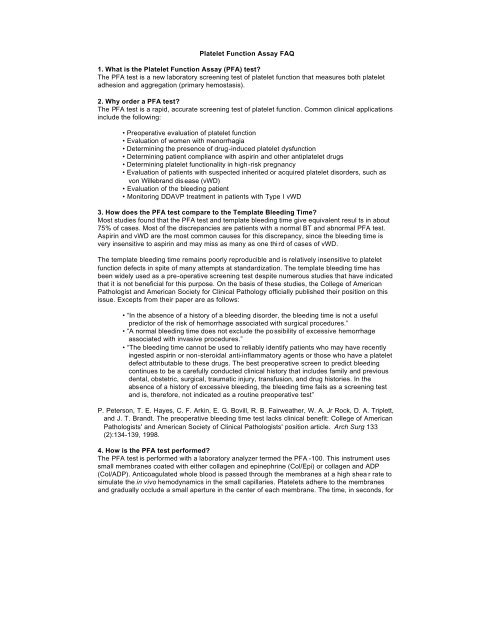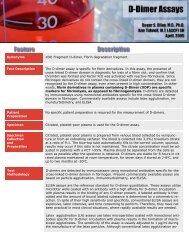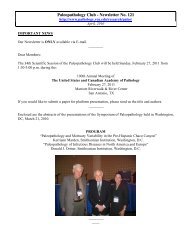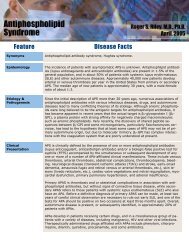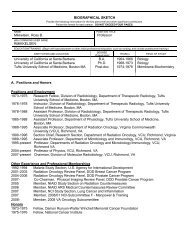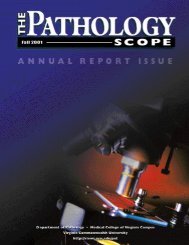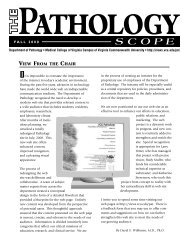Platelet Function Assay FAQ - Pathology
Platelet Function Assay FAQ - Pathology
Platelet Function Assay FAQ - Pathology
You also want an ePaper? Increase the reach of your titles
YUMPU automatically turns print PDFs into web optimized ePapers that Google loves.
<strong>Platelet</strong> <strong>Function</strong> <strong>Assay</strong> <strong>FAQ</strong><br />
1. What is the <strong>Platelet</strong> <strong>Function</strong> <strong>Assay</strong> (PFA) test?<br />
The PFA test is a new laboratory screening test of platelet function that measures both platelet<br />
adhesion and aggregation (primary hemostasis).<br />
2. Why order a PFA test?<br />
The PFA test is a rapid, accurate screening test of platelet function. Common clinical applications<br />
include the following:<br />
• Preoperative evaluation of platelet function<br />
• Evaluation of women with menorrhagia<br />
• Determining the presence of drug-induced platelet dysfunction<br />
• Determining patient compliance with aspirin and other antiplatelet drugs<br />
• Determining platelet functionality in high-risk pregnancy<br />
• Evaluation of patients with suspected inherited or acquired platelet disorders, such as<br />
von Willebrand disease (vWD)<br />
• Evaluation of the bleeding patient<br />
• Monitoring DDAVP treatment in patients with Type I vWD<br />
3. How does the PFA test compare to the Template Bleeding Time?<br />
Most studies found that the PFA test and template bleeding time give equivalent resul ts in about<br />
75% of cases. Most of the discrepancies are patients with a normal BT and abnormal PFA test.<br />
Aspirin and vWD are the most common causes for this discrepancy, since the bleeding time is<br />
very insensitive to aspirin and may miss as many as one third of cases of vWD.<br />
The template bleeding time remains poorly reproducible and is relatively insensitive to platelet<br />
function defects in spite of many attempts at standardization. The template bleeding time has<br />
been widely used as a pre-operative screening test despite numerous studies that have indicated<br />
that it is not beneficial for this purpose. On the basis of these studies, the College of American<br />
Pathologist and American Society for Clinical <strong>Pathology</strong> officially published their position on this<br />
issue. Excepts from their paper are as follows:<br />
• “In the absence of a history of a bleeding disorder, the bleeding time is not a useful<br />
predictor of the risk of hemorrhage associated with surgical procedures.”<br />
• “A normal bleeding time does not exclude the possibility of excessive hemorrhage<br />
associated with invasive procedures.”<br />
• “The bleeding time cannot be used to reliably identify patients who may have recently<br />
ingested aspirin or non-steroidal anti-inflammatory agents or those who have a platelet<br />
defect attributable to these drugs. The best preoperative screen to predict bleeding<br />
continues to be a carefully conducted clinical history that includes family and previous<br />
dental, obstetric, surgical, traumatic injury, transfusion, and drug histories. In the<br />
absence of a history of excessive bleeding, the bleeding time fails as a screening test<br />
and is, therefore, not indicated as a routine preoperative test”<br />
P. Peterson, T. E. Hayes, C. F. Arkin, E. G. Bovill, R. B. Fairweather, W. A. Jr Rock, D. A. Triplett,<br />
and J. T. Brandt. The preoperative bleeding time test lacks clinical benefit: College of American<br />
Pathologists' and American Society of Clinical Pathologists' position article. Arch Surg 133<br />
(2):134-139, 1998.<br />
4. How is the PFA test performed?<br />
The PFA test is performed with a laboratory analyzer termed the PFA -100. This instrument uses<br />
small membranes coated with either collagen and epinephrine (Col/Epi) or collagen and ADP<br />
(Col/ADP). Anticoagulated whole blood is passed through the membranes at a high shea r rate to<br />
simulate the in vivo hemodynamics in the small capillaries. <strong>Platelet</strong>s adhere to the membranes<br />
and gradually occlude a small aperture in the center of each membrane. The time, in seconds, for
lood to completely occlude the aperture is referred to as the Closure Time (CT).<br />
The reason for using two membranes is to differentiate between drug -induced platelet defects<br />
and other platelet defects. The Col/Epi membrane is very sensitive to all platelet function defects,<br />
including aspirin-induced platelet dysfunction. In contrast, the Col/ADP membrane is relatively<br />
insensitive to short-term aspirin effect.<br />
5. How are the results interpreted?<br />
The PFA test result is dependent on platelet function, plasma von Willebrand Factor level, platelet<br />
number, and (to some extent) the hematocrit.<br />
The PFA test is initially performed with the Col/Epi membrane. A normal Col/Epi closure time<br />
(183 sec onds), the Col/ADP test is automatically<br />
performed. If the Col/ADP result is normal (183 seconds, Col/ADP >122 seconds) may indicate<br />
the follow ing;<br />
• Anemia (hematocrit 150) about<br />
the PFA-100 can be assessed though PubMed or other on-line services.


